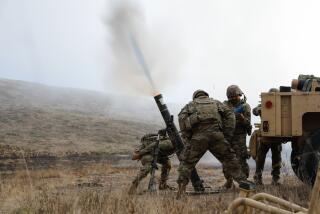Historic Facilities on Closings List : Rich Past No Guarantee of Secure Future for Posts
- Share via
WASHINGTON — The list of defense installations marked for closing in the name of cost-efficiency is a roll call of America’s colorful military history--a catalogue of the names and places where the Army and Navy first put down roots and millions of draftees met the pain and indignities of life in uniform.
There was no allowance for nostalgia in the report of the 12-member base-closing advisory panel, which chose its victims with an eye on the bottom line rather than their place in history.
If Congress goes along, for example, and closes the Presidio in San Francisco, military activity will cease in what has been a fortified area since King Charles III of Spain first stationed troops there in 1776.
The commission also marked for extinction the Brooklyn Naval Station in New York, site of the first U.S. shipyard in 1801, and Utah’s Ft. Douglas, originally built in 1862 to protect stagecoach routes and telegraph lines from Indian raids in the then-wild West but now enclosed by the University of Utah campus.
Illinois’ Ft. Sheridan--named after himself in 1888 by Civil War cavalryman Philip H. Sheridan, the Army’s commanding general at the time who personally signed the order--was on the panel’s hit list, too. It has been a home for some of the Army’s most famous names through the years, including a young second lieutenant named George S. Patton Jr. in 1909.
Less pleasant memories are associated with other bases on the list, however. Chanute Air Force Base in Illinois, when it processed 200,000 men through technical training in World War II, was known as “Cardboard City” and “Splinterville” because of its substandard housing. A recent military guide said that there still has been a short wait for “inadequate quarters” at the facility.
Ft. Dix, N.J., recommended for semi-active status, is the major Army base in the northeastern part of the country to which raw recruits were sent for basic training. It, too, is likely to generate little nostalgia.
“It was absolutely dreadful,” recalls one Ft. Dix survivor who trained there in the 1950s. “There was no heat in the barracks and no hot water and nearly everybody got sick.” In the bloodless language of the Commission on Base Realignments and Closures, however, the installations on its list are all expendable from a military point of view.
“The Presidio has no excess administrative-space capacity,” the report said. “The net cost of closure and relocation will be paid back within two years. The commission expects annual savings to be $74.1 million.”
The Presidio is a federally registered landmark and has about 300 historically important buildings. The wooded area of 1,400 acres overlooking the Golden Gate Bridge is the largest U.S. military reservation within city limits. After Spanish troops departed, the Presidio saw the buckskin-clad men of explorer John Charles Fremont and became a tent city to house survivors of the San Francisco earthquake and fire in 1906.
In World War I, it was a prison for enemy aliens and, in World War II, whistles from ships in San Francisco Bay near the Presidio signaled the opening of the huge nets spread to prevent enemy submarines from entering the bay.
An officers’ club at the Presidio is the only building left of the tile-roofed adobe structures built by the Spanish in the 18th Century. A cemetery with 16,000 graves--including many Indian fighters and a woman who served as a spy for the Union in the Civil War--presumably will be turned over to the Veterans’ Administration for upkeep.
Ft. Sheridan--a 700-acre facility along Lake Michigan amid some of Chicago’s most expensive suburban real estate--today has a resort-like atmosphere in summer months. Beaches with picnic tables and barbecue pits are situated below picturesque bluffs, and the fort includes an 18-hole golf course and a skeet range. Troops stationed in its ancient wooden barracks during winter, when winds howled off the lake, were less comfortable.
“The commission recommends Ft. Sheridan for closure primarily because it is located in a heavily urbanized, high cost area with minimum potential for future growth,” the report said in unemotional prose. “Its mission and tenants can be relocated. . . . The commission expects annual savings to be $40.8 million.”
In another recommendation, the panel urged the shutdown of Ft. Wingate ammunition storage depot, near Gallup, N.M., one of the oldest Army forts still on active duty. Originally built in 1850 to protect settlers against Indian raids, Ft. Wingate was declared obsolete by the commission, with projected savings of $5.2 million a year.
Although several of the bases targeted for closure have colorful histories, others cannot even claim that distinction as a reason for survival.
In discussing the Philadelphia Naval Hospital, for instance, the panel said that its facilities were unsafe and inadequate for modern health care even though it was constructed just before World War II.
“Because of its deteriorated condition and outmoded configuration, the existing hospital cannot be modernized,” the report said. “This 50-year-old facility has deteriorated to the point where the only usable components for a new facility would be the exterior masonry and the structure.”
In another observation on the sad state of many military bases, the commission said:
“The continued presence of large numbers of wooden buildings erected during World War II and designed to stand for 10 years at most is but one example . . . of deteriorating facilities. . . . Antiquated structures are common and are not restricted to any single service or mission area.
“The commission encouraged the Department of Defense and the Congress to consider the adverse impact that inadequate living and working conditions have on the performance and retention of personnel.”
It recommended shutdown of one Army facility that no one--not even the Army--could oppose. The facility: a helicopter landing pad “in a state of disrepair and unusable” at Cape St. George, Fla., that has no current or future Army mission.
“The closure will have minimal impact on local employment due to the fact that no personnel are assigned to Cape St. George,” the report declared.
Staff writer Ronald J. Ostrow contributed to this story.
More to Read
Sign up for Essential California
The most important California stories and recommendations in your inbox every morning.
You may occasionally receive promotional content from the Los Angeles Times.










